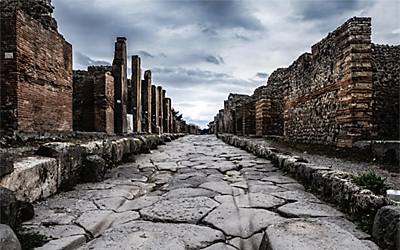From the Beginning: The History of Pompeii and the Eruption of Vesuvius

William McMahon Ball Theatre Old Arts (Building 149)
MapUnearthing Pompeii Short Course - Session 1
The eruption of Vesuvius in AD 79 has preserved not only buildings, including their wall paintings and mosaics, but also items of everyday life that disappeared long ago from most of the Roman cities excavated elsewhere. At Pompeii (and Herculaneum) objects such as combs, mirrors and glass vessels have been preserved. Even the Pompeiians themselves and their animals survive in a series of remarkable plaster casts. From casts and wall-paintings, we are able to reconstruct the precise appearance of houses and shops, the beds and couches they sat upon, what they ate and the dinner services they used. At Herculaneum, not only are wooden beams, shop shutters, garden trellises and ceilings preserved, but even the bread, nuts and eggs that were to be eaten that day. Such is the wealth of information uncovered in these buried cities that we know from election posters who was standing for office in a particular year, from inscriptions the name of the architect of the theatre at Pompeii, and from graffiti people’s opinion of various gladiators.
About the course
Over six consecutive weeks, join us as we journey through the discovery of the perpetual unearthing of Pompeii with comparisons and references to Herculaneum and other ancient buried cities. This short course will closely examine the history, the buildings, public and private spheres of everyday life, recreation, entertainment and art.
Each session includes two one-hour evening lectures with Q&A and a break with light refreshments. Course handouts and further reading material will be available throughout the duration of the course. Certificates of participation will be offered upon completion of the course.
Tickets
Individual session, 2 hours each: $65 / $55^
Series pass, 12 hours: $375 / $300^
^ University of Melbourne alumni, staff and students
Presenter
Professor Emeritus Frank Sear, The University of Melbourne
A world renowned architectural historian and former Chair of Classics at The University of Melbourne, Emeritus Professor Frank Sear is a graduate of Cambridge University, where he completed both his undergraduate and postgraduate studies. He has published widely on his archaeological work and published several books including Roman Wall and Vault Mosaics, Roman Architecture and Roman Theatres: an architectural study. He was coDirector of the Australian Pompeii Project from 1978 to 1988, and since 1990 has directed the Australian Roman Theatres project, which involved surveying the theatres at Gubbio, Taormina, Benevento and Pompeii in Italy, Jerash in Jordan, and Orange in France. Professor Sear has also led numerous archaeological tours in Italy, Croatia, Greece, Turkey, the Middle East, Egypt, North Africa, Spain and France.